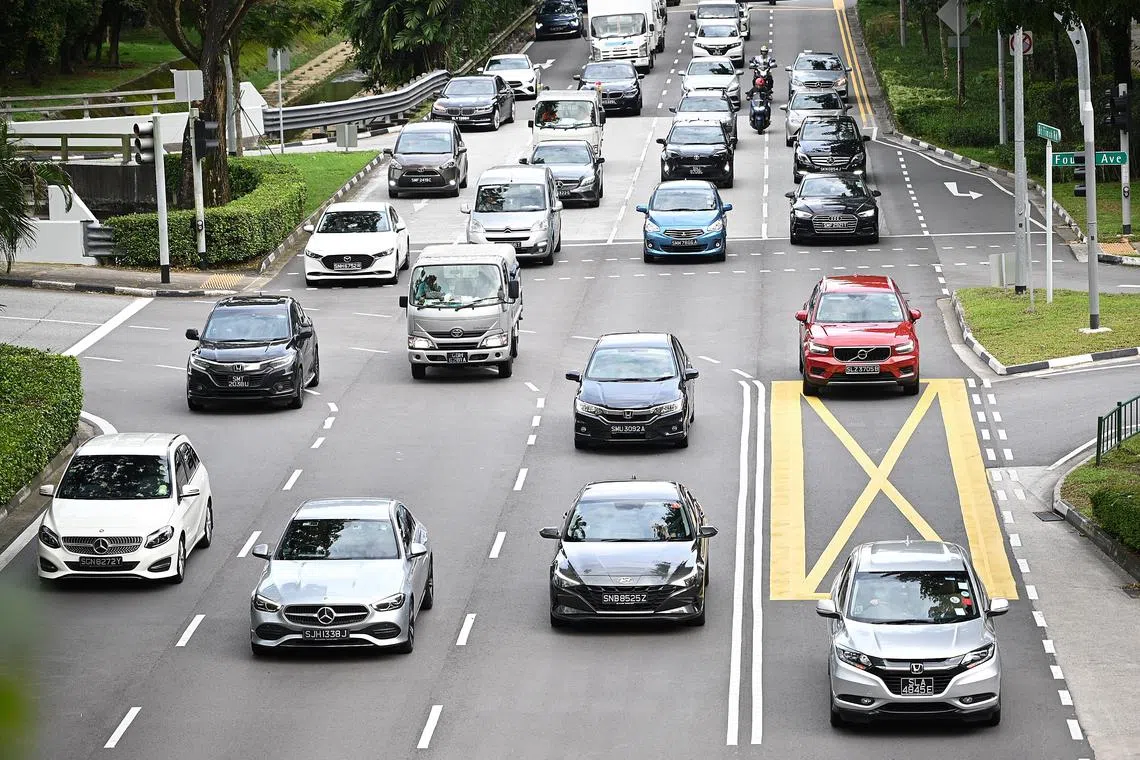Injection of up to 20,000 COEs gives LTA flexibility to boost supply ahead of future peak: Chee
Sign up now: Get ST's newsletters delivered to your inbox

MPs have raised concerns about LTA’s injection of up to 20,000 COEs, questioning its impact on road congestion and Singapore’s car-lite ambitions.
PHOTO: ST FILE
Follow topic:
SINGAPORE - An injection of up to 20,000 more certificates of entitlement (COEs) over the next few years will allow the authorities to better meet an earlier promise of increasing COE supply before a projected peak in 2026, Transport Minister Chee Hong Tat told Parliament.
Mr Chee said this on Nov 12 in response to questions from MPs on both sides of the political aisle about the Land Transport Authority’s (LTA) recent announcement that it would increase Singapore’s vehicle population by up to 2 per cent
“We had earlier said that the COE quota for categories A, B and C will continue to increase every quarter before reaching the projected peak supply from 2026,” Mr Chee said, referring to earlier moves to fill supply troughs by redistributing COEs due to expire in future.
“The additional COEs will give us more flexibility to meet this commitment, and further increase the COE supply in the next few quarters before we reach the peak supply,” he added.
Workers’ Party MP Jamus Lim (Sengkang GRC) asked Mr Chee if the injection was a firmer commitment by the Ministry of Transport to eliminate the “feast-and-famine volatility” of COE premiums.
Replying, Mr Chee said the move will aid LTA’s efforts to further flatten the COE supply curve.
As more COEs are added to the pool, LTA will continue to monitor traffic conditions and adjust Electronic Road Pricing (ERP) charges where necessary to keep congestion in check, he added.
On the impact that an injection of COEs will have on premiums, Mr Chee said a supply increase should help to moderate prices. But this will also depend on demand, which the minister said has been strong, especially among individual Singapore buyers.
At the latest tender on Nov 6
MPs had raised concerns about LTA’s injection of up to 20,000 COEs, questioning its impact on road congestion and Singapore’s car-lite ambitions.
In response, Mr Chee said having a car-lite vision does not mean that the total car population cannot grow.
Furthermore, an increase in the vehicle population does not automatically lead to an increase in usage, since car owners may still choose to take public transport to work, or use their cars mainly during off-peak periods, Mr Chee added.
Instead, the key to preventing congestion is through ownership controls, which is what the COE system does, as well as usage-based pricing, he said.
The minister said a reduction in vehicle use between 2019 and 2023, and the introduction of the new satellite-based ERP system, or ERP 2.0, has given LTA the leeway to increase COE supply.
Mr Chee cited LTA figures, which showed that the total vehicle mileage in Singapore fell by about 6 per cent from 2019 to 2023. There has also been lower traffic in the Central Business District.
Because of this, there has been no need to switch on ERP gantries in the city cordon, as well as in arterial roads such as Toa Payoh Lorong 5, he added.
With ERP 2.0, Mr Chee said, LTA will have even more tools to manage congestion, as the system will provide more comprehensive aggregated traffic information.
The new system, which is in the midst of being rolled out, will allow LTA to quickly set up “virtual gantries” based on the latest traffic patterns for more flexible and responsive congestion management.
While ERP 2.0 has the ability to levy a charge on car usage by distance travelled, Mr Chee said no decision has been made on whether to roll this out.
He also emphasised that the planned injection of 20,000 COEs is unrelated to the implementation of distance-based charging. But he left the door open for further increases in COE supply, should the authorities decide to go ahead with distance-based charges in future.
Mr Melvin Yong (Radin Mas) asked Mr Chee about the Government’s key considerations when deciding whether to roll out distance-based charging.
Mr Chee replied that such a move will affect various groups of drivers differently, including those who need to drive for work and, therefore, travel longer distances.
“That is one of the key considerations that we are looking at in designing the distance-based charging policies,” he added.
MPs had also asked about the impact of EV subsidies on COE prices.
Mr Yip Hon Weng (Yio Chu Kang) wondered if LTA’s goal was still for Singapore to go car-lite or if the primary focus has shifted to the move from petrol cars to EVs.
Mr Chee said COE demand is driven by how many people want to buy cars, not the type of car they end up buying.
The tax rebates for EVs, which go up to $40,000 today, are intended to nudge car buyers towards EVs by reducing the difference in ownership costs, compared with an internal combustion engine or a hybrid equivalent.
How EVs are priced is ultimately a business decision for motor dealers, Mr Chee added.
“If they submit higher COE bids than what they had included in their pricing, it will eat into their profit margins. Hence, there is no commercial incentive for electric car dealers to excessively mark up their prices or bid for higher COE just because of the EV subsidies.”
The minister said the Government remains committed to a car-lite vision, with public transport being the main mode of travel.
Hence, the authorities will continue to invest heavily in expanding the rail and bus networks, and continue to subsidise public transport journeys.
“A car-lite vision doesn’t mean no cars... What we want to manage is the congestion,” Mr Chee later said in response to further queries from Mr Yip.
“It’s about increasing the ‘walk, cycle, ride’, and the public transport mode share,” he added, referring to LTA’s “walk, cycle, ride” vision of encouraging travel through means other than cars.


